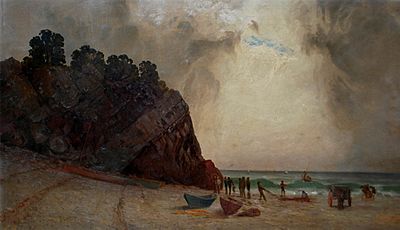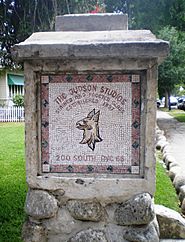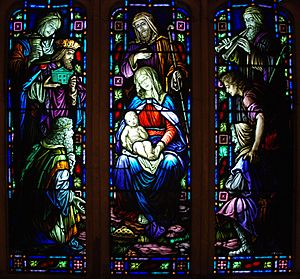Judson Studios facts for kids
|
Judson Studios
|
|
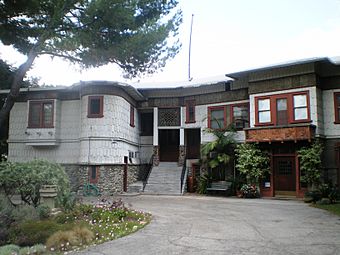
Judson Studios, May 2008
|
|
| Location | 200 S. Avenue 66, Highland Park, Los Angeles, California |
|---|---|
| Built | 1911 |
| Architect | Train & Williams |
| Architectural style | Shingle Style American Craftsman—Bungalow |
| NRHP reference No. | 99000370 |
Quick facts for kids Significant dates |
|
| Added to NRHP | March 25, 1999 |
Judson Studios is a special art studio in Highland Park, a part of northeast Los Angeles. This studio is famous for making beautiful stained glass art.
It was started in the mid-1890s by an artist named William Lees Judson, who was from England, and his three sons. They first opened their studio in downtown Los Angeles. In 1920, they moved to their current spot, and it's still a family-run business today! The Judson Studios building was recognized as a special historic place by Los Angeles in 1969. It was also added to the National Register of Historic Places in 1999, which means it's important to the whole country.
Contents
Meet William Lees Judson, the Founder
William Lees Judson was born in 1842 in Manchester, England. When he was ten, he moved to the United States with his family. After serving in the American Civil War for four years, Judson studied art in New York and Paris.
He became a successful portrait painter and art teacher in London, Ontario. In 1890, he moved to Chicago. But because he wasn't feeling well, he moved to Los Angeles in 1893. He settled near the Arroyo Seco river. This area was home to many talented artists.
A radio show in 1937 said that Judson "fell in love" with the Arroyo Seco right away. It became his home for the rest of his life. Soon after arriving, Judson became a leader in the Arroyo Guild of Craftsmen. This group of artists, sculptors, and architects helped the Arts and Crafts Movement grow in Southern California.
The beautiful scenery made Judson switch from painting people to painting landscapes. His landscape paintings were so good that in 1896, he became a professor at the University of Southern California. In the late 1890s, he started the Los Angeles College of Fine Arts at his home. This is where Judson Studios is located today. William Lees Judson passed away at his home in the studio building in October 1928.
How Judson Studios Began
After moving to Los Angeles, William Lees Judson realized there wasn't a good local studio for stained glass. In 1895, he convinced his three sons, Walter H., Lionel, and Paul, to join him. They came to Los Angeles to help him start a stained glass business.
The family first called their business Colonial Art Glass Co. It was located in Mott Alley, near the Old Plaza and Union Station. This area was later torn down to build the Hollywood Freeway.
In the early years, Judson Studios made stained glass for both churches and regular buildings. They even worked with famous architects like Frank Lloyd Wright. They created glass and tile for his Ennis and Barnsdall Houses. Besides stained glass, the Judsons also worked with tile and mosaic art.
Their work became so well-known that they were able to hire major artists. These artists, like A.E. Brain and Frederick Wilson, even left America's top stained glass maker, Louis Comfort Tiffany, to work for Judson.
The College of Fine Arts Connection
Judson first taught at McLeod's Los Angeles School of Art and Design. Later, his own art college became the USC College of Fine Arts. Judson moved the college to the building near his home in the Arroyo area in 1901. Other records say the school was at the Highland Park location from 1897 to 1920. He became the Dean of the USC College of Fine Arts in 1913. He stayed in that role until he retired in 1922.
The First Building and a Fire
The first building on the Garvanza site was a three-story building with an Islamic style. It was used as the campus for the USC College of Fine Arts starting in 1901. In December 1910, a fire destroyed this building. Many of Judson's artworks were lost. Judson himself escaped the burning building through a window. He even held his classes that day under the pepper trees on the property!
A New Studio Built in 1911
After the fire, a new, larger two-story building was constructed in 1911. It was designed by Robert Train and Robert Edmund Williams. This new building was home to the USC College of Fine Arts until 1920. That's when USC moved the art school to its main campus.
With USC moving out, Judson Studios moved into the building. In its early days, the building was also a meeting place for the Arroyo Craftsmen. This group made furniture and art for beautiful homes until World War I. They even created pieces for famous Arts and Crafts Movement architects, Greene and Greene. Important visitors to the building included Frank Lloyd Wright, Ernest A. Batchelder, and Henry and Charles Greene.
How the Studios Operate
When Walter H. Judson passed away in 1934, Horace T. Judson took over. Horace was William Lees Judson's grandson. Even though he was trained as a lawyer, Horace stopped practicing law to continue the family's stained glass business.
In 1940, the studios were described as "a medieval guild." This meant they worked slowly and carefully, just like artists did centuries ago. Horace Judson told a local newspaper, "Here there is no rush. We work slowly and for perfection."
After World War II, Southern California grew very fast. Many new churches were built, which meant a lot of work for Judson Studios. In the 1950s, they had 30 skilled artists working there. Walter W. Judson, who later ran the business, remembered it was almost too busy. So, Horace Judson made a rule: the studio would never have more than 15 artists at once. Walter continued this rule, saying, "If you go over 15, you'll make more money. But you can lose your reputation too."
In 1973, Walter Judson said it was hard to find people who truly loved the craft. He noted that many just wanted to try it and then leave. By 1981, Judson Studios was still using "the old methods that have yet to be improved." Walter Judson explained, "We do use a lot more electricity and glass costs a lot more but that's about all that's changed." At that time, Judson used glass from all over the world, in more than 600 colors!
In 1986, the Los Angeles Times wrote about the studios. They noted that nine artists worked there, using techniques that hadn't changed much since the 12th century. In 1991, Walter Judson believed that modern stained-glass art was even better than the art from the 11th and 12th centuries. He added, "It's a unique business, because you're producing something that is a joy and a beauty to other people and it will be for centuries."
While Judson Studios is best known for stained glass, they also create art in other ways. They do marble carving, mosaics, carved and etched glass, furniture, and other special items.
As of 2017, Judson Studios was still a family business. David Judson, the great-great-grandson of William Lee Judson, was the director. In 2000, David Judson said that 85% of their work was for religious buildings. This included churches, synagogues, and mosques.
Saving the Historic Studios
From 1920 to 1969, Judson Studios operated in a neighborhood meant for homes. As a special permit was ending in 1969, the Judson family worried the city might make them tear down the studios. To save the studios, the Los Angeles Cultural Heritage Board, with the family's help, declared the building a Los Angeles Historic-Cultural Monument in August 1969. It was Monument No. 62.
The historic declaration said that Judson Studios had made amazing stained glass windows for many buildings. These buildings were all over the United States and in other countries. It also said that Judson Studios was one of the biggest in the nation. It was probably the largest on the West Coast. The declaration noted that the studio had stayed in the family and helped Los Angeles's art and culture grow. The building was added to the National Register of Historic Places in 1999.
Amazing Examples of Judson Stained Glass
Over its first 100 years, Judson Studios created more than 10,000 stained-glass artworks. You can find their beautiful stained glass all over Southern California and the United States. Here are some places where you can see their work:
- The Hollyhock House at Barnsdall Art Park and the Ennis House. Judson Studios made leaded and stained glass and tiles for these famous Frank Lloyd Wright homes.
- The round skylight at the Natural History Museum in Los Angeles.
- The "Congressional Prayer Room" (also called the "Chapel of All Creeds") at the U.S. Capitol building.
- The United States Air Force Academy Cadet Chapel in Colorado Springs, Colorado.
- Chapel One at Edwards Air Force Base in California.
- The Alumni Memorial Window at the Memorial Branch Library in Los Angeles. This window honors Los Angeles High School students who died in World War I.
- The huge inside dome – 107 by 35 feet – at the Tropicana Resort & Casino in Las Vegas. This cost $200,000 to make!
- The 30-foot Jewel Court Dome at South Coast Plaza in Costa Mesa, California.
- The Caesars Palace Palace Court dome in Las Vegas.
- Sun City Ginza in Tokyo.
- Mary, Queen of the Universe Shrine in Orlando, Florida. Judson made 94 stained-glass windows for this shrine.
- Highland Park Presbyterian Church in Los Angeles.
- St. James' Episcopal Church in South Pasadena.
- All Saints Church in Pasadena.
- First Congregational Church in Los Angeles.
- Calvary Presbyterian Church in South Pasadena (see image to the right). You can see it from outside at night.
- Westminster Presbyterian Church in Los Angeles. Judson designed the stained glass windows in 1930 for this church.
- "The Life of Christ" window series at St. Barnabas Church in Eagle Rock.
- The Stanford Court Hotel in Nob Hill, San Francisco.
- A special design with white lions and tigers for Las Vegas illusionists Siegfried & Roy.
- Toluca Lake United Methodist Church in North Hollywood. Judson started making windows here in 1958 and was still installing them in 1992.
- The 36-foot high Great Window at Glendale Presbyterian Church in Glendale, California. Completed in 1974, it shows a Pentecost theme with a large figure of Christ and people from different backgrounds.
- The tree of life window in the Lopaty Chapel at Valley Beth Shalom in Encino, California. This window is made from 20,000 pieces of glass and has 613 leaves.
- The Arbor of Light Radiance Corridor at the Mountain View Mausoleum in Altadena, California.
- The Diamond Head Mortuary in Honolulu, Hawaii.
- The Goldman Estate in Honolulu.
- Honolulu International Country Club.
- All Saints Episcopal Church, San Diego. Stained glass work was completed between 1957 and 1967.
The Church of the Resurrection Project
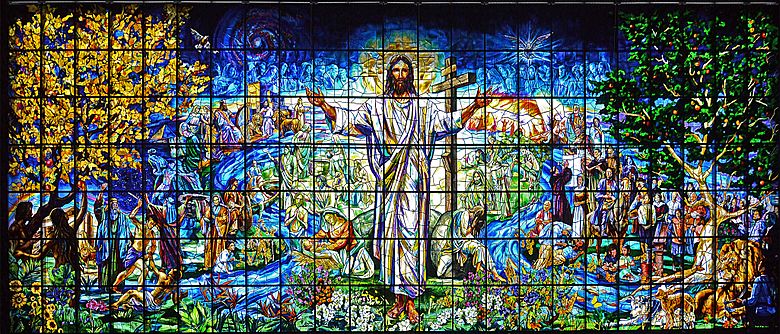
This project for the United Methodist Church of the Resurrection is one of Judson Studio's biggest and most challenging works. They had to invent new ways to use fused glass and even build a new facility in South Pasadena to complete it.
Visiting Judson Studios
The Judson Gallery often has different art shows that anyone can visit. The Studios also offer one-hour tours of their workshops and galleries. These tours cost $20 per person and happen on the second Thursday of every month.
See also





